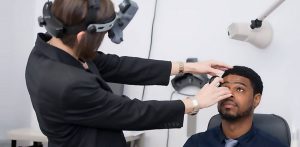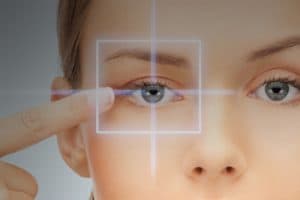When is Blurred Vision a Medical Emergency?
Almost everyone experiences blurry vision. If a headache occurs with or causes blurred vision, it may be due to an underlying condition or medical emergency.
Read More2021 Update: Treatments for BVD
Up to 20% of the world’s population suffers from Binocular Vision Dysfunction (BVD). What is BVD? Binocular Vision Dysfunction (BVD) is caused by the two
Read More2021 Update: Lazy Eye and Adults
Lazy eye is estimated to affect up to 5% of all adults. For many decades, it has been thought that only children under the age
Read MoreWhat Are Visual Efficiency Problems?
Poor visual efficiency skills can negatively impact performance in school, at the office, and on the sports field. Understanding and knowing what to look out for can help with early detection and treatment of visual problems – leading to improved school grades and sports achievements.
Read MoreEyes and Obesity
Obesity is a global medical epidemic, research clearly shows the direct correlation between obesity and eye diseases. Studies show that obesity increases the risk of
Read MoreBVD and Motion Sickness
Binocular Vision Dysfunction (BVD) is a condition where the eyes are misaligned and the visual system struggles to send one clear image to the brain. BVD can cause dizziness and motion sickness due to the visual system’s difficulties in fusing together the images from each eye.
Read MoreWhat Are Eye Flashes?
Have you ever been startled by the appearance of small flashes of light out of the corner of your eye? Eye flashes When eye flashes
Read MoreFeeling Anxious? You May Have a Vision Problem
Anxiety disorders affect millions of people each year. But did you know that certain vision problems can actually trigger anxious thoughts and feelings? Binocular vision
Read MoreTinted Lenses for Color Blindness
An estimated 1 in 12 men and 1 in 200 women has some degree of color blindness. Color blindness is not an actual blindness, but
Read MoreStanford University: Concussions and Oculo-Motor Dysfunction
This month, a presentation was given by Dr. Jamshid Ghajar, MD, PhD, FACS at the Stanford Brain Performance Center (Department of Neurosurgery and Stanford Athletics),
Read MoreAre You Suffering From Post-Concussion Symptoms?
Up to 90 percent of people experience post-concussion symptoms for many years… until they receive effective treatment from a neuro-optometrist. Post traumatic vision syndrome (PTVS)
Read MoreMeniere’s Disease
Meniere’s disease affects 2 in 1000 adults and over 45,000 new cases are diagnosed each year. What is Meniere’s disease? Meniere’s disease is an inner
Read MoreSixth Nerve Palsy
Sixth nerve palsy, also called abducens nerve palsy, is a rare condition that occurs when the sixth cranial nerve, also called the abducens nerve, becomes damaged.
Each year, around 11 in 100,000 people are diagnosed with sixth nerve palsy.
The sixth cranial nerve is responsible for sending signals to the lateral rectus muscle. When the sixth cranial nerve becomes damaged, it prevents the lateral rectus muscle from operating and results in an inward eye turn (esotropia) and double vision.
Read MoreThird Nerve Palsy
Third Nerve Palsy, also called Oculomotor Palsy, occurs when the third cranial nerve becomes injured or diseased.
The third cranial nerve controls the actions of four external eye muscles. As the third cranial nerve controls many of the eye’s muscles and functions, palsy of this nerve can result in complete or partial paralysis of the eye.
Fourth Nerve Palsy
Fourth Nerve Palsy, also known as Superior Oblique Palsy or Trochlear Nerve Palsy, occurs when the fourth cranial nerve becomes diseased or damaged. The fourth cranial nerve controls the actions of the superior oblique eye muscle and is responsible for turning the eye inward and downward.
Read MoreWhat Is Neuroplasticity?
Neuroplasticity refers to the brain’s ability to change and adapt in response to new experiences. It was once thought that the nerve fibers in the
Read MorePrism Lenses for Double Vision
Double vision is a relatively common problem, and is responsible for 850,000 visits to the doctor and hospital each year. Double vision, also known as
Read MoreLight: A Form of Therapy?
Author: Dr. Aaron Nichols Excel Neuro-Optometric Clinic Light therapy is now being used as a treatment to help people regain their quality of life following
Read MoreNystagmus
Nystagmus is an eye condition that causes repetitive involuntary eye movements. These movements can cause the eyes to move from side to side, up and down, or in circular motions. Nystagmus frequently leads to unsteady and impaired vision and depth perception which can cause poor balance and coordination.
Read MoreVisual Rehabilitation FAQs
These are the 10 most frequent questions asked to vision therapy eye doctors on vision therapy following a head injury. You may easily find answers to your questions below. If you still have questions, contact your nearest eye doctor experienced in TBIs, concussion and vision therapy
Read MoreCan a Stroke Cause Vision Problems?
Approximately 60 percent of stroke patients develop some form of visual impairment. A stroke occurs when there is an interruption of blood flow to the
Read MoreWhat Is Post-Traumatic Vision Syndrome?
Over 90 % of concussions and traumatic brain injuries (TBIs) result in some degree of visual dysfunction. Post traumatic vision syndrome (PTVS) is the clinical
Read MoreHow to Protect Yourself from a Brain Injury
Over 47 percent of all TBIs are caused by falls, especially for adults over the age of 65. Traumatic brain injuries (TBI) can occur from
Read MoreTraumatic Brain Injury and Neuro-Optometry
What is a neuro-optometrist? Neuro-optometrists diagnose and treat visual problems related to neurological conditions and traumatic brain injuries (TBI). Through rehabilitative treatment, neuro-optometrists retrain and
Read MoreConcussion and Vision
Author: Dr. Aaron Nichols Excel Neuro-Optometric Clinic The term concussion has become increasingly popular in the last several decades. The research behind the causes and
Read MoreOn the Long Road to Recovery: Motion Sickness and TBI
Author: Dr. Aaron Nichols Excel Neuro-Optometric Clinic Do you experience motion sickness while driving a car or motorcycle, or riding as a passenger? Motion sickness
Read MoreLighting Up the Room: Light Sensitivity Post-TBI
Author: Dr. Aaron Nichols Excel Neuro-Optometric Clinic Are you experiencing light sensitivity since your traumatic brain injury? Following a traumatic brain injury (TBI) there are
Read MoreOcular Oncology
What is ocular oncology? Ocular oncology involves the diagnosis and treatment of all tumors that occur in or around the eye— tumors of the eyelid,
Read MoreGuide to Dry Eye
Do suffer with dry eyes? There are a range of very successful treatment now available that can offer you significant relief from your symptoms. The key is receiving the right diagnosis and appropriate advice from your eye doctor.
Read MoreWhat is Low Vision?
Do you or a loved one have low vision? Low vision is diagnosed when vision cannot be fully corrected with glasses, contact lenses, or eye surgery— allowing you to participate in every day activities. It is often accompanied by blurred vision, blind spots or tunnel vision— and may also be called legal blindness. Low vision may prevent you from driving, watching TV, reading, using a computer or participating in your favorite hobbies.
Read MoreHypertropia or Hyperphoria?
Hypertropia and hyperphoria are when the eyes are misaligned – one pointing higher than the other. Both these forms of eye turn can be well managed by optical lenses and vision therapy, often avoiding eye surgery.
Read MoreA Guide to Children’s Eye Diseases
As your child grows older, annual exams are crucial to ensure that their eyes continue to develop normally, and to detect any changes in vision or ocular health. Importantly: vision screenings conducted by schools are not a substitute for a comprehensive eye exam – ocular diseases and many vision problems cannot be identified through a screening.
Read MoreNeuro-Optometry
Have you suffered a traumatic brain injury (TBI) or concussion and still experiencing vision problems? TBIs can cause double vision, blurriness, headaches and eye strain, these can be successfully treated with a personalized vision therapy program.
Read MoreVision for Special Needs
Children with special needs have a high rate of visual problems and their lives can be enhanced with the correct eye care. Vision therapy has also been shown to improve the visual skills to improve eye contact and interactions with their surroundings – significantly enhancing their lives.
Read MoreVision Therapy for Lazy Eye
Lazy eye is a common vision problem, affecting up to 1 in 20 (5%) of all children. Has your child been treated for lazy eye, yet the vision remains poor? Lazy eye can be successfully treated for both children and adults, with new digital techniques using computer-based 3D games.
Read MoreVision and Vestibular Dysfunction
Do you often experience dizziness or feel as though the world is spinning around you (vertigo)?
Do you experience motion sickness, or a persistent sense of unsteadiness or imbalance? You may have an inner ear disturbance called Vestibular Dysfunction. The good news is that these symptoms can be significantly reduced with vision therapy, allowing you to regain your quality of life.
Vision Problems from a Brain Injury
Can a brain injury cause vision problems? Yes, any traumatic brain injury (TBI) can have significant visual consequences. During the initial treatment of a concussion or other traumatic brain injury (TBI), visual problems are often overlooked. Frequently, visual problems are hidden or neglected— lengthening and impacting rehabilitation.
Read MoreVision Therapy for TBI Related Vision Conditions
How does a TBI affect vision? Vision is the most important source of sensory information. Consisting of a sophisticated complex of subsystems, the visual process
Read MoreCommon Vision Problems Associated With a Brain Injury
Over 10 million traumatic brain injuries (TBI) occur annually, worldwide. Approximately 2.8 million, close to 1 in 100, Americans suffer a form of TBI every
Read MoreVision Therapy for Traumatic Brain Injuries: Success Stories
Below are stories from children and adults who have suffered a traumatic brain injury (TBI) and their experiences with Vision Therapy. *Names have been altered
Read MorePost Trauma Vision Syndrome
A Guide to Post Trauma Vision Syndrome Author: Dr. Allen Cohen OD, FCOVD Dr. Cohen is currently Clinical Professor of Optometry, SUNY State College of
Read MoreVision, Dizziness and Imbalance
Many people experience dizziness or balance issues following a mild concussion or other traumatic brain injury (TBI). Dizziness or imbalance can be caused by a
Read MoreVision and Brain Injuries
Can the eyes and visual system be affected by a brain injury? Yes, Traumatic brain injury (TBI) can result in significant vision problems, unfortunately these often remain undiagnosed for years, dramatically impacting the quality of life.
Read More5 Essential Facts About Traumatic Brain Injuries
Have you suffered a brain injury? Here are 5 facts that are essential to know: A traumatic brain injury (TBI) is an injury to the
Read MoreHow Does a Traumatic Brain Injury Cause Vision Problems?
Brain injuries can lead to vision problems, especially in children. We often think of a Traumatic Brain Injury (TBI) affecting adults, however consider these facts:
Read More








































